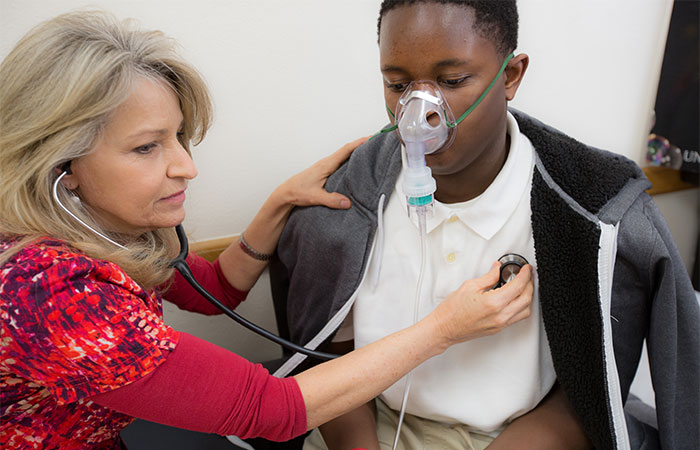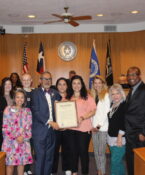Catching a breath
By Jeff Carlton
Kiasha Jones has managed her son’s asthma for the last 14 years, ever since he was diagnosed at age 6 months following a bout with a respiratory virus called RSV.
Armed at home with an inhaler, a humidifier and a nebulizer that delivers medication to the lungs in aerosol form, Jones’ son Derek James is mostly unhindered by his respiratory condition – and even plays football for Fort Worth’s Polytechnic High.
But last year, Derek’s asthma flared up at school. Such attacks would once typically trigger a call to paramedics and a trip to the emergency room.
In Derek’s case, however, a nurse at Forest Oak Middle School quickly treated him in her office with a nebulizer and a low dose of the asthma-fighting medication known as albuterol. Then she sent him back to class.
The nurse was able to respond quickly and effectively thanks to an innovative pilot program led by UNT Health Science Center called “Asthma 411.” It gives school nurses the equipment, training and medical clearance to treat students’ asthma attacks in the schools, keeping children from missing class, parents from missing work and reducing costly trips to emergency rooms.
“During the school day, the nurse is going to see Derek a lot more than I do,” Jones said. “I wouldn’t have known what to do without the albuterol and the nebulizer machine being right there.”
Such a program is essential in Fort Worth and other major metropolitan areas where the percentage of children who have asthma is roughly triple the national average. The program takes a community approach to address the problem and includes collaborative partners such as the Fort Worth Independent School District, Cook Children’s Medical Center, MedStar Mobile Healthcare and JPS Health Network.
“This project reinforces what many of us already know about our community,” said Andrew Crim, Executive Director of the Office of Professional and Continuing Education (PACE) at UNTHSC. “Fort Worth has a number of individuals willing to work together to make it a better place.”
‘A growing problem’
About 8.6 percent of children in the United States have asthma, according to the Centers for Disease Control and Prevention. But closer to 25 percent of Fort Worth children have it, a figure similar to what is seen in other urban areas, said David Sterling, PhD, Professor of Biostatistics and Epidemiology, School of Public Health.
“Of the many risk factors for asthma, we have all of them,” Dr. Sterling said.
There are three key factors that contribute to Fort Worth’s high asthma rates, he said:
- Geography: Texas is awash in allergens such as ragweed and mountain cedar – much of it bothersome year round.
- Environment: In 2016, the American Lung Association rated the Dallas-Fort Worth metropolitan area No. 11 nationally for pollution with respect to ozone.
- Demographics: People with lower incomes have higher rates of asthma than other groups, often due to substandard housing and associated issues such as dust mites, cockroach droppings, mold and mildew. Lack of access to health care also is a predictor of asthma and asthma severity.
These all contribute to the region’s high asthma rates – and experiences that are truly frightening for children experiencing an attack, said Leslie Allsopp, MPH, a third-year doctoral student in the School of Public Health. During an attack, the smooth muscles of the airway contract at the same time the immune system is busy secreting mucous, further narrowing the airways.
“Having an asthma attack is like drinking a thick milkshake through a straw,” Allsopp said. “You are trying to inhale and exhale through these very narrow openings.”
‘It’s very scary’
If anyone understands the fear a child experiences during an asthma attack, it’s Andrea Smith, RN. She has spent 24 years as a nurse, the last four at Forest Oak Middle School in Fort Worth.
“You can tell from the minute they walk in the door,” she said. “The child is short of breath and can’t talk. You don’t know if their airway is going to shut down, where they can’t get any oxygen in.
“You don’t know what’s going to happen, and it’s very scary thinking about what could happen with this kid.”
Before Asthma 411, Smith could check to see if the child had an inhaler stored in her office along with a signed parental consent form and a physician’s order. If the proper paperwork wasn’t on file, her choices were limited: Lead the child in breathing exercises. Call a parent. Or call a paramedic.
After Asthma 411, the protocol improved. For parents who provide consent, their children can now receive treatment of albuterol delivered through a nebulizer, resources that were donated to the school by Cook Children’s. Critically, a blanket standing order for treatment from Jay Haynes, MD, Senior Medical Director for Employee Health and Wellness at JPS, eliminated the need for parents to go to their child’s pediatrician for an order.
Tobi Jackson, a Fort Worth ISD Board of Education trustee, is a former principal who has witnessed a student suffering an asthma attack while waiting for paramedics to arrive.
“It’s terrible to feel so helpless – and even worse for the kid,” she said. “That’s why I jumped at the chance to pilot this program in two schools in my district. I knew firsthand the difference it could make – and it has.”
In a small sample size, the program has yielded dramatic results. In the 2012-13 school year, MedStar reported 19 emergency calls for asthma from the two Fort Worth ISD schools participating in the pilot program. In the following two school years, there was one such call. Asthma-related student absences dropped 51 percent over the same time period.
Nationally, asthma contributes to more than 14 million lost school days each year. Excessive school absences are a strong predictor of premature dropout rates, Dr. Sterling said.
“The bottom line is we are keeping these kids in school,” said Pam McFadden, Associate Vice President of PACE. “Because we’re focused on reducing 911 calls, the children can focus on their math and reading.”
Now, and Next
The underlying concept for Asthma 411 isn’t new. Indeed, Dr. Sterling ran a similar project under a CDC grant when he worked at St. Louis University School of Public Health.
What is new – and innovative – is how the project came together and the collaborations that made it possible. When attempts here to start a similar program didn’t receive initial funding, Crim and McFadden in the PACE office took an interest and saw an opportunity.
They won grants from the pharmaceutical companies GlaxoSmithKline and Boehringer Ingelheim, brought in Dr. Sterling and Allsopp for their expertise and secured the cooperation of Fort Worth ISD, Cook Children’s, JPS and MedStar.
They’re not finished. The next phase of the project, dubbed Asthma 211, will provide more resources and supplies for families to improve the indoor conditions of their homes, offer more education and provide direct links for medication. McFadden and Crim want to see it in every Fort Worth school, as well as the programs that provide afterschool care for thousands of children.
In the meantime, the original Asthma 411 program continues to have a positive impact on school nurses – and the students they care for.
“We are with these children for eight hours a day,” Smith said. “They are our responsibility, and Asthma 411 makes a big difference for us.”





Social media